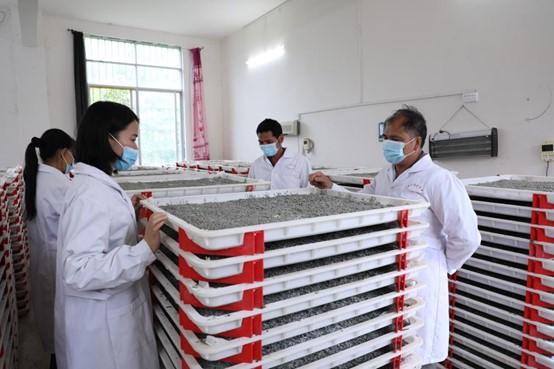
A view of a mulberry farm lining both sides of a country road in Nanpo Township, Jingxi city, Guangxi Zhuang Autonomous Region, in south China (Photo by Wang Churan / Xinhua)
Located in south China near the Vietnam border, farming has long been a challenge in the karst-dominated landscape that covers many parts of Guangxi Zhuang Autonomous Region. Cultivation of grain and other staple crops is not easy due to the thin, fragmented layer of surface soil present in the region, which caused locals to seek alternative solutions. Very adaptable and resilient, mulberry trees can flourish in this type of environment if they are cared for properly, however, and can thus provide a new path forward capable of transforming the local economy when their leaves are used as feed for silkworms as part of sericulture.
Guangxi Zhuang began pursuing and developing the sericulture industry in the early 21st century. An initiative was launched to simultaneously address the fact that the agricultural sector was losing its comparative advantage in the middle and lower reaches of the Yangtze River and the Pearl River Delta – China's traditional silkworm-rearing regions – due to the rising costs of land and labor in them and parts of southwestern China being in need of development and also suited to the industry, thus freeing up land for greater economic development in the country's sericulture hotbeds while enriching areas where it is implemented. The project was initially launched in Guangxi Zhuang and gradually spread throughout the region, eventually making its way to Nanpo – a local township located in Jingxi City – and other administrative areas both within and outside of the autonomous region.
The provision of training for local citizens, establishment of cooperatives, and other initiatives gradually resulted in the emergence of mulberry and silkworm industry chains featuring farming, processing, and sales and the achievement of industrial scale, standardization, and brand building and development, and Guangxi Zhuang eventually became the country's top provincial-level administrative silkworm-rearing area. The industry remains an important part of China's agriculture, and its role in national economic development and cultural diffusion cannot be underestimated.
According to Zhao Xiao, director of a facility that provides training and technical services to sericulturists in the Jingxi area known as the Jingxi Sericulture Technical Guidance Station, the key to successful silkworm farming begins with selecting the right mulberry varieties.
"We've introduced new high-yield mulberry varieties with larger leaves and provide farmers with the tools to start mulberry cultivation and silkworm rearing on the right foot," Zhao explained in August.
Successful sericulture requires more than just healthy mulberry trees capable of generating high output, however – the endeavor is a craft that demands precision and skill. Without obtaining necessary knowledge and implementing proper techniques, farmers risk losing both their silkworms and the money they invest in the undertaking.
Recognizing this reality, Huang Wenxue, a prominent mulberry grower in Nanpo, converted part of his home into a classroom for farmers, where he offers hands-on training to fellow villagers. Huang has conducted over 50 training sessions as of August 2024, equipping more than 3,000 participants with essential skills, which has been an instrumental part of making silkworm farming a viable source of income for people living in the area.

Staff tend to young silkworms in a rearing house in Jingxi's Ande Township. (Photo by Wang Churan / Xinhua)
The industry is also thriving in nearby Ande Township. Local expert Nong Shengke established a rearing room for recently born silkworms, successfully addressing their potential vulnerability to disease and thus ensuring that farmers have access to high-quality silkworms, thereby improving their chances of success.
"Our customers tell us that the survival rate of the silkworms they buy is very high and that their cocoon production has been stable," Nong shared during an inspection of the facility.
Demand for quality cocoons continues to rise. Huang Bo, a silkworm farmer living in Nanpo, noted in August that merchants from Guangdong Province, in southeast China, place orders before his silkworms have even fully matured. In 2024 alone, he expects to earn between RMB200,000 and RMB300,000 (US$28,120 to US$42,180) from cocoon sales.
Nanpo official Huang Yuzhou is optimistic about the future of sericulture in the region. "Investment requirements are low, results can be achieved quickly, and returns tend to be high," he explained. "A single silkworm rearing-house can produce up to three batches of cocoons within two months."
Rising cocoon prices have spurred farmers to expand their operations, which has resulted in sericulture becoming a cornerstone of the Nanpo economy.
The mulberry silk industry has taken root in a total of 19 of Jingxi's townships as of August 2024 and emerged as a pillar of economic growth in the city. With more than 8,786 ha dedicated to mulberry cultivation and over 11,000 farmers engaged in the sector, the area is expected to produce 14,500 tonnes of fresh cocoons by the end of the year, and total output value is projected to exceed RMB900 million (US$126.54 million).
Hard work and innovation are making it possible for Jingxi's farmers to weave a future of prosperity for themselves and generations to come on top of the silk that they are producing.